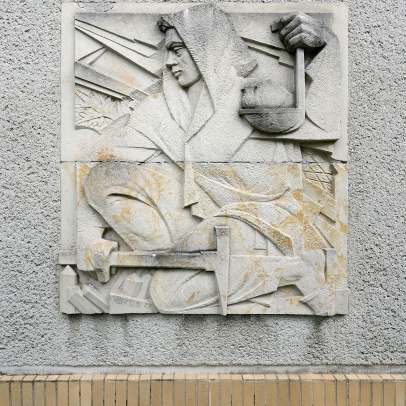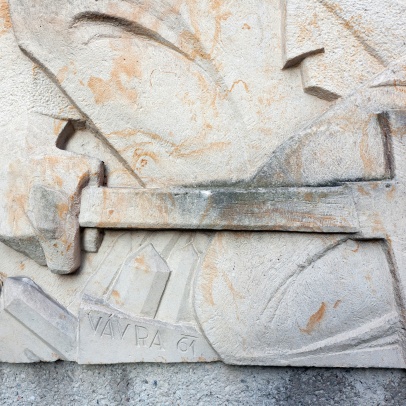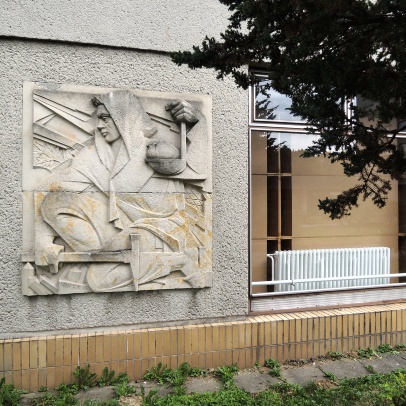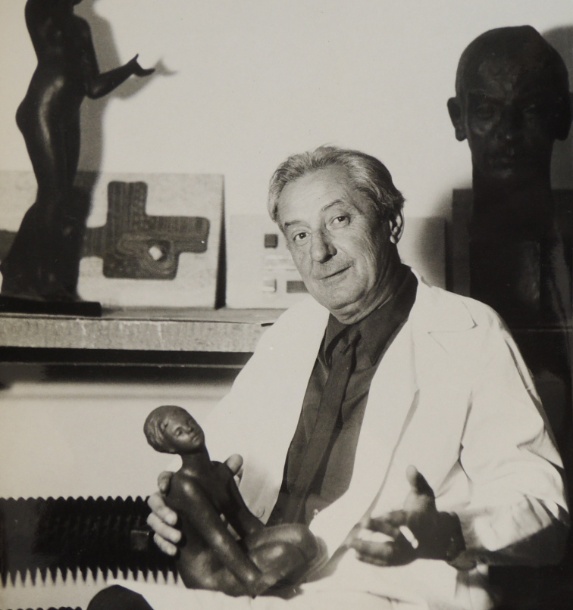Name: Miner
Author: Karel Vávra (architectural cooperation for the new location: Zdeněk Kupka)
Dating: realization 1961, transfer 1982
Location: in 1982 relocated to the outer wall of the glass-walled corridor connecting Block I and II of the atrium of the VŠB-TUO student halls of residence in Poruba
Execution: a relief from Hořice sandstone, 197 x 185 cm
MODERNITY IN MEDIEVAL ATTIRE
Vávra’s Miner is a high-quality relief, in the architecture an unusual, nearly quarter format. The figure of a kneeling miner with working tools is tersely conceived in sharp cuts and projected against the hint of a coal seam in the background. The sculpture transforms from a low to high relief.
A male figure in miner’s attire with a hood, holding a miner’s pick and a miner’s lamp occupies the entire area of the relief. In contrast, the sculptor highlighted the face and hands with the attributes in higher relief in simplified volumes, while the clothing and the background appear flatter. Vávra proceeded from experience in creating architectural sculpture that he enriched with the more modernistic stylization of chiselled forms. As for the figure details – the top of the hood, the hand with the miner’s lamp, the pick, or the kneeling leg project beyond the frame – thus reinforcing the monumentality of the relief. Even in this, for Ostrava, traditional theme, some features characteristic of the Brussels style, which dominated art shortly after the world exhibition, Expo 58, were emphasized. Vávra leaned towards it in the form of clear lines, composed in the system of noticeable diagonals. However, for the Ostrava environment, the sculptor chose an unusual historicist approach to the miner – he clothed him in a hooded cowl similar to that which can be found, for example in the painting from the late 15th century in Hašplířská Chapel at the Church of St. Barbara in Kutná Hora. Vávra’s interpretation of the subject, but also its form, makes this work different from the similar period portrayals of a miner representing the former working-class of the socialist society. He replaced the descriptively realistic form with monumental stylization and moved away from his more traditional approach, which can be found in the figures related in an iconographic sense, also from the early 1960s, on the facades of the residential buildings in Sokolská Street or in the Šalamouna housing estate.
In 1982, the relief was moved from its original location on the outer wall of the building of the Faculty of Mining and Geology in Silesian Ostrava (formerly the building of the Teachers’ Institute, demolished after 2000). The sculptor did not participate in its relocation. The necessary repairs and new mounting were ensured by Alois Hlubek.



